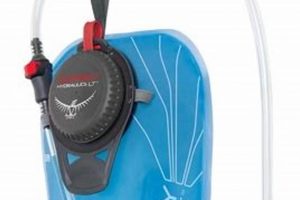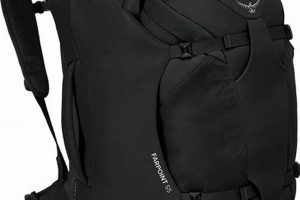Maintaining the cleanliness of specialized outdoor gear, such as load-carrying packs designed for hiking and backpacking, is crucial for longevity and optimal performance. Accumulated dirt, sweat, and debris can degrade fabric, compromise water resistance, and foster unpleasant odors. Regular and proper care extends the lifespan of this equipment.
Neglecting the maintenance of this equipment can lead to premature wear and tear, potentially resulting in costly replacements. Cleanliness also contributes to hygienic conditions, preventing the growth of mold and bacteria that thrive in damp, soiled environments. A well-maintained pack retains its structural integrity and functional capabilities, enhancing user experience during outdoor activities.
The following guidelines outline a practical approach to cleaning and maintaining your pack, ensuring it remains a reliable companion for years to come. This will include instruction on preparation, cleaning methods, drying, and storage.
Essential Steps for Pack Cleaning
The subsequent recommendations provide a detailed guide to maintaining the cleanliness and extending the life of specialized load-carrying equipment. Adhering to these procedures will ensure optimal performance and prevent premature degradation of materials.
Tip 1: Empty and Prepare. Before commencing any cleaning procedure, thoroughly empty all pockets and compartments. Remove any detachable components, such as hip belts or shoulder straps, if feasible. This ensures comprehensive cleaning access.
Tip 2: Brush Off Loose Dirt. Utilize a soft-bristled brush to remove loose dirt, mud, and debris from the exterior surfaces of the pack. Pay close attention to seams, zippers, and areas prone to accumulation.
Tip 3: Hand Wash with Mild Soap. Fill a tub or sink with lukewarm water and add a small amount of mild, non-detergent soap. Submerge the pack and gently scrub the fabric with a soft sponge or cloth. Avoid harsh chemicals or abrasive cleaners.
Tip 4: Rinse Thoroughly. After washing, ensure all soap residue is completely removed by rinsing the pack thoroughly under running water. Residual soap can attract dirt and compromise water-resistant coatings.
Tip 5: Air Dry in a Shaded Area. Hang the pack upside down in a well-ventilated, shaded area to air dry. Avoid direct sunlight or heat, as these can damage the fabric and cause discoloration. Ensure the pack is completely dry before storing.
Tip 6: Address Stains Promptly. Treat stains immediately upon discovery. Employ a specialized stain remover appropriate for the fabric type, following the manufacturer’s instructions carefully. Avoid vigorous scrubbing, which can damage the material.
Tip 7: Zipper Maintenance. Regularly lubricate zippers with a silicone-based lubricant to ensure smooth operation and prevent corrosion. This will prolong the lifespan of the zippers and avoid costly repairs.
Regular cleaning and proper storage are crucial for preserving the performance and extending the lifespan of load-carrying equipment. Implementing these steps will contribute to a more enjoyable and reliable outdoor experience.
Following these guidelines constitutes a foundational element in preserving specialized outdoor gear, ensuring continued performance and longevity.
1. Preparation crucial
The initial phase in the maintenance protocol significantly influences the efficacy of the entire cleaning process and subsequent performance of the pack. Thorough preliminary actions guarantee optimal access to all surfaces and components, facilitating a more comprehensive clean and minimizing the risk of damage.
- Complete Unloading of Contents
The initial step necessitates removing all items from every compartment, pocket, and attachment point. Neglecting this can hinder access to soiled areas, trap moisture, and potentially damage enclosed electronics or sensitive gear during the cleaning process. The consequence of incomplete unloading translates to incomplete cleaning, and potentially, equipment malfunction.
- Detachment of Removable Components
Many packs incorporate removable components such as hip belts, shoulder straps, framesheets, and hydration reservoirs. Detaching these elements allows for individual cleaning, preventing the transfer of dirt and grime from one area to another. This also allows for a more thorough inspection and treatment of these components, prolonging their lifespan and preventing the buildup of odor-causing bacteria.
- Pre-Cleaning Inspection
A detailed pre-cleaning inspection identifies specific areas of concern, such as stubborn stains, tears, or areas with significant dirt accumulation. This inspection informs the selection of appropriate cleaning agents and techniques, preventing the use of overly aggressive methods on delicate materials or overlooking areas requiring specialized attention. Early detection of damage also enables timely repairs, preventing further deterioration.
- Zipper Preparation
Zippers are a critical component of any pack. Prior to cleaning, ensure all zippers are fully opened to allow for the removal of debris trapped within the teeth. Using a soft brush or toothbrush, gently clean along the zipper tracks. This prevents abrasion and ensures smooth operation post-cleaning. Neglecting this step can lead to zipper failure, rendering the pack unusable.
These preparative measures are not merely procedural steps but integral components of a preventative maintenance strategy. By addressing potential issues before the cleaning process begins, one can ensure a more effective and less damaging cleaning experience, extending the functional life of the pack and preserving its intended performance characteristics.
2. Gentle Cleaning Agents
The selection and application of appropriate cleaning solutions represent a critical juncture in the maintenance process. The inherent materials in load-bearing packs, often characterized by specialized coatings and durable yet potentially delicate fabrics, necessitate the utilization of cleaning agents formulated to minimize the risk of damage or degradation.
- pH-Neutral Formulations
Cleaning solutions with a neutral pH are preferred due to their reduced potential for disrupting the chemical composition of pack fabrics and coatings. Highly acidic or alkaline solutions can weaken fibers, dissolve water-resistant treatments, and cause discoloration. Examples include specifically formulated outdoor gear washes or mild, non-detergent soaps. The application of a pH-neutral agent ensures the fabric’s integrity and performance characteristics are preserved.
- Avoidance of Harsh Chemicals
Chemicals such as bleach, ammonia, and strong solvents pose a significant threat to the structural integrity of pack materials. These substances can corrode fabrics, damage stitching, and compromise the effectiveness of protective coatings. Furthermore, residual chemicals can cause skin irritation and environmental harm. The exclusive use of milder alternatives is imperative to maintain the pack’s physical properties and prevent negative consequences.
- Concentration and Dilution
Even mild cleaning agents can cause harm if used in excessive concentrations. Adhering to the manufacturer’s recommended dilution ratios is critical to minimizing the risk of damage. Over-concentration can leave residue on the fabric, attracting dirt and compromising breathability. Proper dilution ensures the cleaning agent is effective without jeopardizing the material’s integrity.
- Spot Testing Prior to Full Application
Prior to applying any cleaning agent to the entire pack, it is advisable to perform a spot test on an inconspicuous area. This allows for the assessment of potential colorfastness issues or adverse reactions between the cleaning agent and the pack’s materials. This preventative measure can avert widespread damage and inform the selection of a more appropriate cleaning solution if necessary.
In summation, the careful selection and controlled application of gentle cleaning agents directly correlate to the long-term preservation and optimal performance of load-bearing equipment. Prioritizing pH-neutral formulations, avoiding harsh chemicals, adhering to recommended dilution ratios, and conducting spot tests collectively mitigate the risk of material degradation, ensuring the pack remains a functional and reliable asset.
3. Thorough rinsing essential
In the context of maintaining specialized load-bearing packs, such as those manufactured by Osprey, complete removal of cleaning agent residue is paramount. The procedure of “how to clean osprey backpack” necessitates meticulous rinsing to mitigate potential deleterious effects. Inadequate rinsing leaves residual soap or detergent within the pack’s fabric and seams. This residue attracts dirt and grime, negating the benefits of the cleaning process and potentially accelerating fabric degradation. Furthermore, residual cleaning agents can compromise the performance of durable water repellent (DWR) coatings commonly applied to pack fabrics, diminishing their water resistance capabilities. For example, a pack used in wet environments with unremoved soap residue might exhibit increased water absorption and prolonged drying times, impacting user comfort and potentially damaging contents.
The implications extend beyond mere cosmetic concerns. Residue buildup can foster the growth of mold and mildew, particularly in packs frequently exposed to moisture or humidity. This biological growth presents hygiene concerns and can impart unpleasant odors. A pack used for multi-day hiking trips, improperly rinsed after cleaning, might develop a musty smell and become a breeding ground for bacteria. Moreover, the residue can irritate the skin upon contact, especially during extended periods of wear. Therefore, the rinsing phase constitutes a critical control point in the cleaning process, directly influencing the pack’s longevity, hygiene, and performance.
Achieving complete rinsing involves multiple cycles of flushing the pack with clean, lukewarm water until no traces of the cleaning agent remain. Particular attention should be paid to areas prone to residue accumulation, such as seams, folds, and the interiors of pockets. After rinsing, thorough inspection is advisable to ensure all residue is absent. Emphasizing this step, within the broader framework of pack maintenance, directly contributes to preserving the functional integrity and extending the lifespan of the equipment. The failure to prioritize this aspect results in diminished performance and accelerated wear, ultimately undermining the investment in specialized outdoor gear.
4. Avoid direct sunlight
The avoidance of direct sunlight during the drying process is a critical element in the proper maintenance of specialized load-carrying equipment. Exposure to intense solar radiation can induce detrimental effects on the materials commonly used in these packs, impacting their structural integrity and functional characteristics.
- UV Degradation of Fabrics
Prolonged exposure to ultraviolet (UV) radiation from sunlight causes the breakdown of polymer chains within synthetic fabrics such as nylon and polyester. This degradation weakens the fabric, reducing its tensile strength and tear resistance. A pack dried frequently in direct sunlight will exhibit accelerated wear, potentially leading to seam failure and fabric tears, directly compromising its ability to carry loads safely and effectively.
- Fading and Discoloration
UV radiation can also cause dyes to fade and discolor, altering the aesthetic appearance of the pack. While this does not directly impact performance, it can diminish the overall value and perceived quality of the equipment. Certain colors are more susceptible to fading than others, but all fabrics will eventually show signs of discoloration with prolonged exposure. A pack dried indoors or in shaded areas will maintain its original color and appearance for a longer period.
- Damage to Water-Resistant Coatings
Many packs are treated with durable water repellent (DWR) coatings to enhance their water resistance. Direct sunlight can accelerate the breakdown of these coatings, reducing their effectiveness. The heat generated by solar radiation can also melt or soften the coating, causing it to become sticky and attract dirt. A pack dried in direct sunlight will lose its water-resistant properties more quickly, increasing the risk of moisture penetration and damage to contents.
- Heat-Related Stress on Components
Components such as zippers, buckles, and plastic frames can also be negatively affected by direct sunlight. The heat generated by solar radiation can cause these components to warp, crack, or become brittle. This can lead to zipper failure, buckle breakage, and structural instability of the pack frame. Drying a pack in a shaded location minimizes heat stress and extends the lifespan of these critical components.
Therefore, incorporating the practice of drying load-carrying equipment in a shaded environment is an essential component of a comprehensive maintenance strategy. By mitigating the detrimental effects of UV radiation and heat, this practice directly contributes to preserving the structural integrity, aesthetic appearance, and functional performance of the equipment, ensuring its continued reliability and extending its usable lifespan. The proper execution of “how to clean osprey backpack” includes air drying away from sunlight to extend durability.
5. Proper storage vital
The ultimate step in preserving load-carrying equipment involves appropriate storage practices. The condition in which a pack is stored significantly influences its longevity, potentially negating the efforts expended during the cleaning process if executed improperly. Storing a clean pack under unsuitable conditions can lead to accelerated degradation and compromise its overall functionality.
- Control of Moisture and Humidity
Storage environments characterized by high moisture levels foster the growth of mold and mildew, particularly within the fabric and seams of the pack. These biological agents degrade the material, generating unpleasant odors and potentially causing allergic reactions. Proper storage entails selecting a location with low humidity and adequate ventilation. Examples include well-ventilated closets or storage units equipped with dehumidifiers. A dry environment inhibits microbial growth, preserving the integrity of the pack’s materials.
- Protection from Pests and Infestation
Certain pests, such as rodents and insects, can damage pack fabrics in search of food or nesting materials. Storing a pack in a location susceptible to infestation increases the risk of irreparable damage. Proper storage involves utilizing airtight containers or storage bags to physically isolate the pack from potential pests. Regularly inspecting the storage area for signs of infestation and implementing appropriate pest control measures further mitigates the risk of damage.
- Prevention of Physical Distortion
Improper storage can lead to physical distortion of the pack’s frame, straps, and padding. Compressing the pack under heavy objects or storing it in a cramped space can permanently alter its shape, compromising its comfort and performance. Proper storage entails maintaining the pack’s natural shape by hanging it or storing it in a spacious container. Avoid placing heavy objects on top of the pack, and ensure that straps and padding are not compressed or folded in unnatural ways.
- Shielding from Extreme Temperatures
Exposure to extreme temperatures can degrade pack fabrics and components. High temperatures can cause materials to melt, warp, or become brittle, while low temperatures can make them stiff and prone to cracking. Proper storage involves selecting a location with moderate and stable temperatures. Avoid storing the pack in direct sunlight, in uninsulated attics, or in damp basements, as these locations are susceptible to temperature extremes.
These facets underscore the critical role of proper storage in maintaining specialized load-carrying equipment. By controlling moisture, preventing pest infestation, avoiding physical distortion, and shielding from extreme temperatures, one can maximize the lifespan and performance of the pack, ensuring it remains a reliable asset for future outdoor endeavors. Neglecting these storage considerations diminishes the benefits of careful cleaning procedures, ultimately shortening the pack’s usable lifespan.
Frequently Asked Questions
The following addresses common inquiries regarding the cleaning and care of specialized load-carrying equipment, providing detailed answers to ensure proper maintenance and prolonged lifespan.
Question 1: Is machine washing advisable?
Machine washing is generally discouraged due to the potential for damage to fabrics, coatings, and structural components. Agitation and high temperatures can compromise water resistance and accelerate wear. Hand washing is the recommended method.
Question 2: What type of soap is suitable?
A mild, pH-neutral, non-detergent soap is optimal. Avoid soaps containing bleach, fabric softeners, or fragrances, as these can leave residue and damage the fabric. Specialized outdoor gear washes are also acceptable.
Question 3: How often should a pack be cleaned?
Cleaning frequency depends on usage. A pack used regularly in demanding conditions warrants more frequent cleaning than one used occasionally for light activities. Visible dirt, odors, or signs of mildew indicate the need for cleaning.
Question 4: Can a pack be dried in a machine dryer?
Machine drying is strongly discouraged. High heat can damage fabrics, melt coatings, and warp plastic components. Air drying in a shaded area is the recommended method.
Question 5: How should zippers be maintained?
Zippers should be kept clean and lubricated with a silicone-based lubricant. Debris can be removed with a soft brush. Regular lubrication prevents corrosion and ensures smooth operation.
Question 6: Is waterproofing spray necessary after cleaning?
Reapplication of a durable water repellent (DWR) spray may be necessary if the pack’s water resistance has diminished. Follow the manufacturer’s instructions carefully. Ensure the pack is clean and dry before application.
These FAQs provide concise guidance for the proper care and maintenance of load-carrying equipment, ensuring its continued performance and extending its usable lifespan.
The following section outlines additional resources and advanced care techniques for specialized gear maintenance.
Concluding Remarks on Pack Maintenance
The comprehensive exploration of proper pack maintenance, with specific applicability to “how to clean osprey backpack” methods, underscores the necessity of diligent care in preserving specialized outdoor equipment. Emphasized were the critical stages of preparation, gentle cleaning, thorough rinsing, appropriate drying, and proper storage, each contributing significantly to the longevity and optimal performance of the pack. Adherence to these guidelines mitigates the risk of material degradation, prevents the proliferation of harmful microorganisms, and ensures the continued functionality of essential components.
Ultimately, the consistent application of these principles represents a commitment to responsible equipment stewardship. This practice not only extends the lifespan of the pack, maximizing its value, but also contributes to a safer and more enjoyable outdoor experience. A well-maintained pack is a reliable companion, ready to withstand the rigors of the trail and provide secure and comfortable load carriage for years to come. The future utilization of this knowledge will empower individuals to proactively protect their investments and enhance their engagement with the natural world.






![Best Osprey Kestrel 38L Backpack [Review & Guide] Ultimate Backpack Traveler Guide: Tips, Destinations & Budget Hacks Best Osprey Kestrel 38L Backpack [Review & Guide] | Ultimate Backpack Traveler Guide: Tips, Destinations & Budget Hacks](https://backpack-traveler.com/wp-content/uploads/2025/10/th-816-300x200.jpg)
